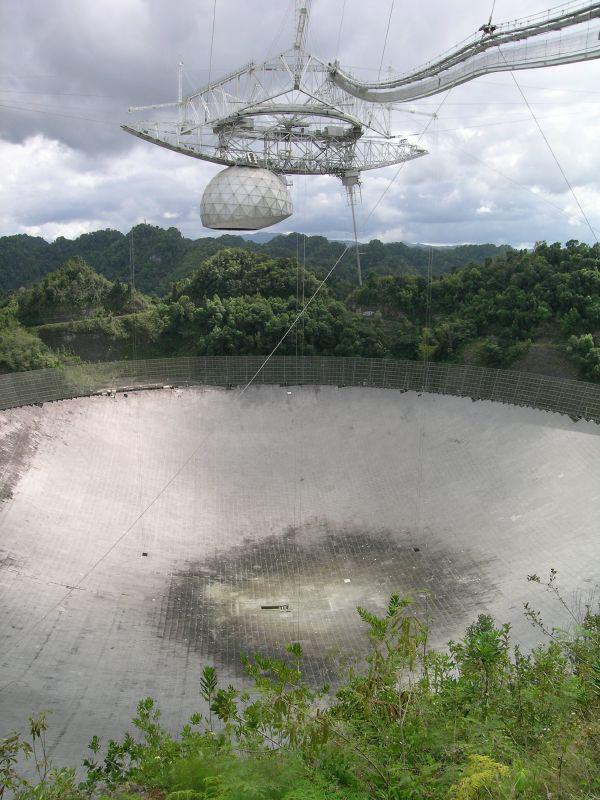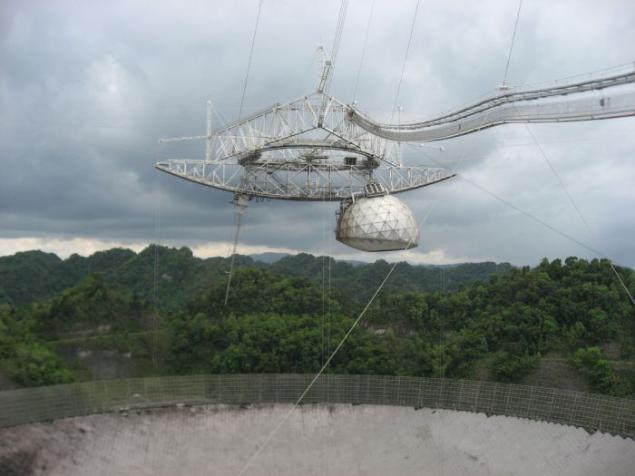The world's largest telescope (6 photos)
 Bashny.Net
Bashny.Net
Radio telescopes in Arecibo - currently the largest in the world (from using the same aperture). The telescope is used for research in radio astronomy, physics of the atmosphere and radar observations of solar system objects.

Astronomical Observatory is located in Arecibo, Puerto Rico, 15 km from Arecibo, at an altitude of 497 m above sea level. Research is conducted by Cornell University in cooperation with the National Science Foundation (USA). The observatory is also the National Center for Astronomy and Ionosphere USA.

Design Features:
Reflector telescopes located in natural sinkholes and covered 38,778 perforated aluminum plates (1 to 2 m), stacked on the mesh of steel wires. Mobile antenna feed, suspended on cables 18 to the three towers.
To conduct research on the program radar astronomy observatory has a transmitter power of 0, 5 MW.

With this transmitter is also sent "Arecibo message" .This is a radio signal that was sent November 16, 1974 from the Arecibo Observatory in the direction of the cluster M13 Hercules, at a distance of 25,000 light years. Post lasted 169 seconds, the wavelength of 12, 6 cm. This was done in honor of the powerful radio telescope

Construction of the radio telescope was launched in 1960. The original purpose of the telescope were study the Earth's ionosphere. Author of the idea of construction: Cornell University professor William Gordon.

The official opening of the Arecibo Observatory held November 1, 1963.
Public Observatory in Arecibo known for several Hollywood films. The giant radio telescope observatory featured, for example, in the movie "Golden Eye" of the epic James Bond and the film "Contact" is based on the novel by Carl Sagan.

Since 1999, information from this telescope comes to handling the project SETI @ home, via computers connected to the Internet volunteers.
Currently, due to funding cuts expected closing of radar astronomy program by October 1, 2007. As a result of lack of funding may complete closure of the observatory in 2011.


Astronomical Observatory is located in Arecibo, Puerto Rico, 15 km from Arecibo, at an altitude of 497 m above sea level. Research is conducted by Cornell University in cooperation with the National Science Foundation (USA). The observatory is also the National Center for Astronomy and Ionosphere USA.

Design Features:
Reflector telescopes located in natural sinkholes and covered 38,778 perforated aluminum plates (1 to 2 m), stacked on the mesh of steel wires. Mobile antenna feed, suspended on cables 18 to the three towers.
To conduct research on the program radar astronomy observatory has a transmitter power of 0, 5 MW.

With this transmitter is also sent "Arecibo message" .This is a radio signal that was sent November 16, 1974 from the Arecibo Observatory in the direction of the cluster M13 Hercules, at a distance of 25,000 light years. Post lasted 169 seconds, the wavelength of 12, 6 cm. This was done in honor of the powerful radio telescope

Construction of the radio telescope was launched in 1960. The original purpose of the telescope were study the Earth's ionosphere. Author of the idea of construction: Cornell University professor William Gordon.

The official opening of the Arecibo Observatory held November 1, 1963.
Public Observatory in Arecibo known for several Hollywood films. The giant radio telescope observatory featured, for example, in the movie "Golden Eye" of the epic James Bond and the film "Contact" is based on the novel by Carl Sagan.

Since 1999, information from this telescope comes to handling the project SETI @ home, via computers connected to the Internet volunteers.
Currently, due to funding cuts expected closing of radar astronomy program by October 1, 2007. As a result of lack of funding may complete closure of the observatory in 2011.

Tags
See also
The world's largest hydroelectric power plant running (6 photos)
In Australia, scientists have published the world's largest solar cells
The world's largest
The world's largest mirror (10 photos)
Open the world's largest Ferris wheel (5 photos)
The world's largest panoramic photo - 365 gigapixel
Tour the largest building in the world
Assembled the largest motorcycle in the world where you can ride
The biggest rabbit in the world
Illegal ascent of the world's largest cable-stayed bridge

















